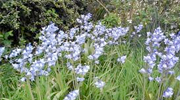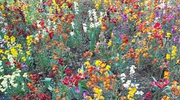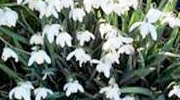
Seasonal Maintenance of your garden
| Spring | |||
March Cut hardy fuchsia and summer flowering clematis. Aerate established lawns. If weather permits – sow new lawns, lay turf, edge and feed lawns. Plant hardy perennials.
|
April Plant evergreen shrubs and trees, rhododendrons. Continue to cut lawns and treat any problem areas, scarify and aerate, apply weed killer. Begin to prepare pots and container plants – check for any signs of aphids. Water and feed fuchsias and pelargonium. |
May Check new lawns and water thoroughly if required. Begin to lower blade setting on cuts for established lawns. Thin out dead and old wood from shrubs and dead head rhododendrons. Plant up containers and hanging baskets if all signs of frost gone. |
|
| Summer | |||
June Ensure that the base of trees and shrubs are kept weed and grass free. Trim privet, hawthorn, berberis and alike. Spike lawns to help rainfall reach roots. Mow regularly but raise cut if drought conditions exist. Continue to lay turf. Weed killer can still be used providing it is watered in well. Water beds thoroughly. Feed hanging baskets or other containers unless slow release fertiliser used – make sure these are watered well (do not allow to dry out) and turned to give balanced growth. Dead head as flowers die off.
|
July Prune deciduous shrubs such as jasmines and philadelphus. Continue to mow at least once a week and aerate and water thoroughly during prolonged dry spells. Try to avoid any chemical treatment during hot spells. Continue to cut back early flowering perennials, tie in and support tall plants. Prepare and create new beds and dig in fertiliser in existing ones. Regularly dead head flowering plants. Ensure consistent and regular watering of container plants and hanging baskets – weekly feed unless slow release fertiliser used. |
August Water and mulch any newly planted shrubs or flowers. Continue to weed and hoe beds. Begin to prepare ground for turfing or sowing. Regularly mow existing lawns. Prune and shape shrubs that have finished flowering. Water container plants daily and feed weekly. |
|
| Autumn | |||
September Continue to treat lawns for moss and weeds. Apply autumn feed, scarify and fork if needed. Begin to raise the cut for mowing. Start to plant bulbs such as lilies and irises. Continue to remove annuals as they die off, empty containers and continue to tidy up borders. Plant up hanging baskets for winter and spring using pansies, primulas, ivies and alike.
|
October Continue to care for your lawn, repair, reseed and apply autumn fertiliser. New lawns can still be prepared using seed or turf. Continue to mow with a raised blade. Tidy beds and borders and mulch with compost or manure. Lift and store Dahlias. Shelter any pots that house shrubs or small trees to avoid the cold and wind. Continue planting winter flowering plants including hanging baskets with Pansies, Violas and alike. Continue to prune dead or broken shoots from shrubs. |
November Continue to plant evergreens and finish off any newly planted hedges. Improve drainage of lawns by aerating and finish off any newly laid turf or seeding where possible. Continue to mow lawns when needed with a relatively high cut. Move non – hardy potted plants in doors. Cover and protect any plants susceptible to frost with bubble wrap, straw, sacking or similar materials. Treat any fencing or decking with a winter protection. |
|
| Winter | |||
December Continue to rake up fallen leaves. Continue to spike and aerate lawns to help with drainage. When weather permits continue to mow using a high cut. Prune back any dead or damaged branches from established shrubs and trees. Tidy beds and borders and keep an eye out for any loose soil around newly planted shrubs caused by frost. Firm back in around plant. Make sure pots and containers are put in sheltered positions to avoid wind and frost damage.
|
January Protect Rhododendrons and Azaleas from any severe frosts or snow. Continue to spike lawns to aerate and drain excess moisture. Continue to mow when weather permits. Start to dig over and weed borders to make the task easier in later months. Ensure pots and containers are still sheltered from adverse weather conditions. Dead head any Pansies or Violas to encourage continued flowering. |
February If the weather is frost free then the first trim of deciduous hedges can be made. Aerate established lawns and apply moss killer where necessary. Continue to mow with a high cut. Watch out for slugs around new growth and treat accordingly. Prepare beds and borders by digging over and applying a general fertiliser or bone-meal dressing. Summer flowering Clematis can be pruned back hard when they start to grow. Planting of deciduous trees and shrubs can now be made during mild spells. |
|
| back to top |



